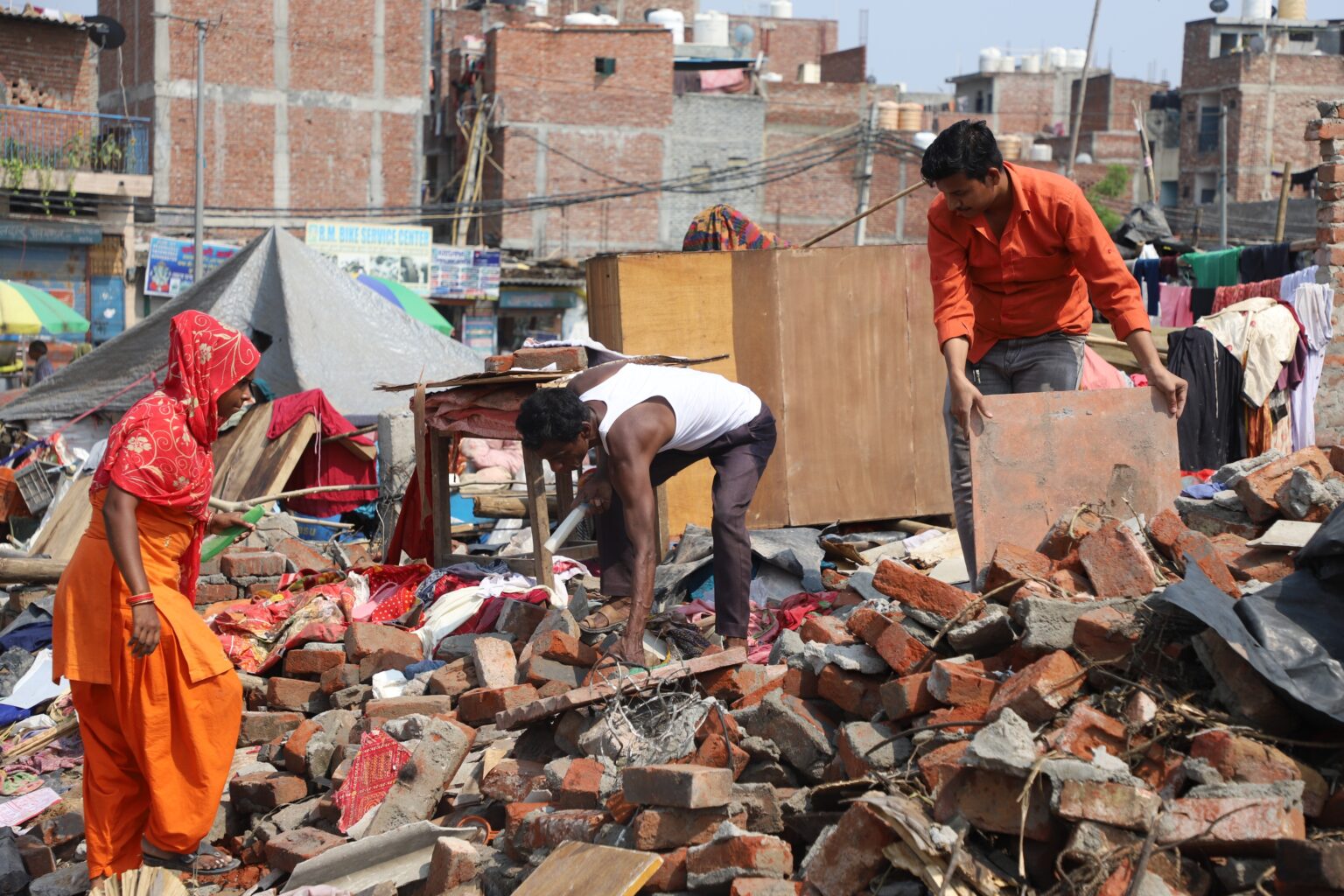In a heartbreaking turn of events, on International Labour Day, houses of thousands of unorganized laborers in India were demolished in South Delhi’s Tughlakabad village, as part of an encroachment removal drive, conducted by the Delhi Development Authority (DDA), and the Archaeological Survey of India (ASI).
Starting from April 30, till May 4, 2023, Tughlaqabad’s Bengal Colony residents saw a brutal spate of heavy police and paramilitary deployment along with huge bulldozers entering their area for four consecutive days.
As per the data assessed by Foej, the demolition drive resulted in the destruction of approximately 1,000 houses, displacing around 5,000 families and rendering nearly 20,000 homeless.

Why this Volume?
The National Capital City of Delhi is home to over 1000 slum colonies, which house approximately 35 percent of the population.
It is the same population who toils hard to contribute significantly to the economic development of the cities, but unfortunately, get often labeled as ‘squatters’ or ‘illegal encroachers’
As you walk past the Tughlakabad fort area on Mehrauli Badarpur road, a cluster of makeshift colonies come into the view. These humble dwellings have long served as colonies of migrant laborers from West Bengal, UP, and Bihar, both Hindus and Muslims.
Despite the hardscrabble existence, the population of these settlements swelled each passing day, as rurals poor poured into the city in search of better prospects.

Plight of De-housed laborers
In the early morning of April 30, as the bulldozers roared across the fort area, the helpless residents could do nothing but watch as their homes were reduced to rubble.
“We are left with nothing,” cried 28-year-old Sunita, a nurse who had invested all her hard-earned savings into building her humble abode.
The authorities did not even spare them a moment to collect their meager belongings before the merciless demolition began, leaving the residents utterly distraught and helpless.
“After investing years of hard work into building our humble small homes, they want us to abandon everything and leave? Where will we even go? My father died two years ago and I live here with my mother. Who will give us shelter”, asked Sunita in a shrieking voice.
Speaking with FOEJ, the anguish in her voice echoed the plight of the thousands others who have been rendered homeless due to a last-minute ruthless demolition drive.
The residents of the colony mainly worked as domestic workers, laborers, rag pickers, scrap workers, painters, and sweeper. They were engaged in various other menial jobs to make their ends meet. Now, this demolition drive has put their livelihoods in jeopardy, and an uncertain future looms large over a significantly large community of migrant laborers.

High Court’s Decision
The demolition drive was initiated in response to the Delhi High Court’s directive to the Archaeological Survey of India (ASI) to clear out all encroachments in and around the Tughlakabad Fort area, citing that it cannot remain a “mute spectator” towards the rampant encroachments.
However, the High Court’s decision has drawn criticism from many quarters, as the same court that had upheld the rights of migrant citizens in Sudama Singh & Others vs Government of Delhi is now allowing the government to demolish homes and displace migrant families.
“When a family living in a Jhuggi is forcibly evicted, each member loses a ‘bundle’ of rights – the right to livelihood, to shelter, to health, to education, to access to civic amenities and public transport and above all, the right to live with dignity,”
Sudama Singh v. Government of Delhi, High Court of Delhi, February 2010
The High Court’s decision is starting to raise questions about the government’s treatment of its most vulnerable citizens. It is ironic that while India has openly condemned forced evictions at various international forums, such value-based commitments seem to be given scant regard within its own boundaries.
No Rehabilitation Policy
After the High Court order came out, residents were asked to vacate the premises at their own expense, within 15 days. Subsequently, the people had appealed to the courts asking for rehabilitation before demolition.
In spite, the ASI, DDA and Delhi Police forcibly evicted thousands of people without any rehabilitation policy in place. Though, High Court directed the Delhi Urban Shelter Improvement Board (DUSIB), DDA and ASI to hold discussions and come up with a solution for rehabilitation.
However, “DUSIB’s role in providing short-term rehabilitation has been poor so far: displaced people have been sent to far away shelter homes that are at great distance from their places of work and from the schools where their children study.
“The shelter homes are at best temporary homes and are not a permanent solution in any sense,” All-India Central Council of Trade Unions (AICCTU), which has been going to the court on behalf of the people, said in a statement with The Citizens.

Despite pleas for rehabilitation, no viable long-term solution was proposed, and the demolitions began anyway. “It cannot be expected that human beings in jhuggi clusters will simply vanish if their homes are uprooted”. Nirmal Gorana, the Mazdoor Samiti convener, slammed the government and the court’s lack of concern for the working-class families, affected by the eviction.
The Samiti is fighting a case for rehabilitation in court on behalf of the residents. Meanwhile, the agitated laborers are staging a peaceful protest at Jantar Mantar, hoping to draw attention to their plight and demand a fair and just solution to their situation.
Development through Demolition?
It is crucial to ask whether demolition is the only way forward to development? Evictions have never achieved any purpose. The displaced settlements are replaced by newer ones, and cities are dependent on the poor working classes to run the economy.
Though a strategy to displace people might result in short-term gains, the trend of increasing urban evictions without any tangible habitat solution for India’s city inhabitants is a cause for concern.
The government should prioritize the development of inclusive and sustainable housing policies that address the needs of all citizens, especially the most vulnerable.










